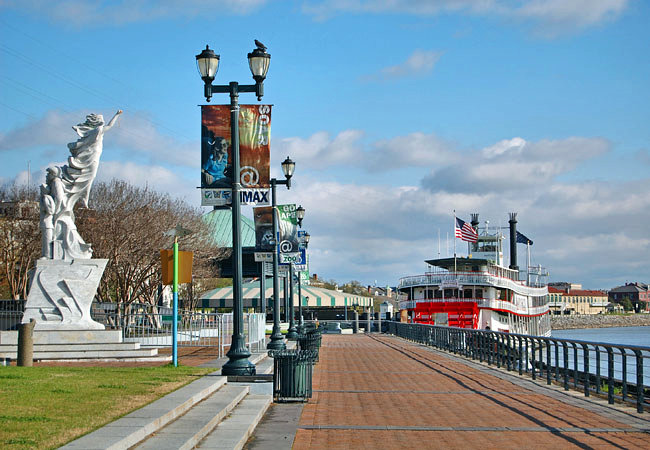The DGA Friends and Family Crawfish Boil is about many things. It's about bringing friends and family together. It's about listening to some awesome local music. And it's also about eating crawfish. But just what are crawfish and why do they taste so good? Let's take a look at the history of these delicious crustaceans and how they've become a culinary staple of south Louisiana.
Crawfish season runs from late February through early June. Crawfish live in the wetlands that surround the Mississippi River and its estuaries. In the centuries before European settlement in Louisiana, the crustaceans thrived in the creeks, lakes, and bayous of south Louisiana. Local native Americans collected crawfish by the bushel by baiting wooden reeds with venison and dipping them into the water. The crawfish would latch onto the meat and dangle off the reeds, providing locals with their dinner.
 |
| All the crawfish! |
When the Acadians arrived in Louisiana in the 1750s, they quickly learned the value and deliciousness of this local delicacy. These French settlers, who had been expelled from Canada by the English during the Seven Years War, began incorporating crawfish into the cuisine. Over the ensuing decades, crawfish became a staple of Cajun cuisine. The Cajuns even created their own legends about the origin of crawfish, demonstrating just how important they had become in Cajun culture. According to the legend, after the explosion of the Cajuns from Canada, local lobsters followed the Acadians from the ice cold waters of the Atlantic to the Mississippi basin. When the lobsters entered the warm waters of the gulf, they shrank to their present size.
The commercial sale of crawfish began only in the late 1800s with the first recorded harvest in 1880. The crawfish, raised in the Atchafalaya Basin, resulted in a harvest of 23,400 pounds, worth about $2,140 (about $51,000 in today’s money). In 1908, the U.S. Census Bureau recorded that Louisiana produced about 88,000 pounds of crawfish per year, worth about $3,600 (about $93,000 today). The Great Depression of the 1930s drove the price of crawfish down to as low as 4 cents per pound. Technological advancements, including trucking, railroads, and refrigeration, fueled the movement of live crawfish from the rural bayou to urban centers like Baton Rouge and New Orleans. The introduction of traps and nets allowed for the collection of greater numbers of crawfish.
 |
| There are entire memes devoted to crawfish. |
In the 1930s, Louisiana began to cultivate the production of crawfish on farms. Rice had long been a staple of bayou farmers. In order to gain more income, rice farmers began re-flooding their fields in order to produce harvests of crawfish in the winter and early spring. This practice soon spread across Louisiana wherever low-lying ponds and marshland could be found.
The process of farming stabilized crawfish production. Before farming, the harvest in any given year depended on the water levels in the Atchafalaya Basin. Thus the market fluctuated wildly from year to year. Now with consistent water levels, farmers could control the size of the harvest and stabilize their incomes. By the mid-1960s, over 10,000 acres of crawfish farms had spread across Louisiana. In the decades since, crawfish farms have increased by a factor of twelve to approximately 120,000 acres. Louisiana accounts for 85%-95% of total U.S. crawfish production.
The process of farming stabilized crawfish production. Before farming, the harvest in any given year depended on the water levels in the Atchafalaya Basin. Thus the market fluctuated wildly from year to year. Now with consistent water levels, farmers could control the size of the harvest and stabilize their incomes. By the mid-1960s, over 10,000 acres of crawfish farms had spread across Louisiana. In the decades since, crawfish farms have increased by a factor of twelve to approximately 120,000 acres. Louisiana accounts for 85%-95% of total U.S. crawfish production.
 |
| Hmm... crawfish |
In 1960, the community of Breaux Bridge was named the crawfish capitol of the world and every year since has held yearly crawfish festival. This growth in production caused Louisiana restaurants to begin featuring crawfish on their menus. Long a staple of Cajun cuisine, crawfish étouffée became a restaurant staple. With its increasing visibility as a product unique to south Louisiana, crawfish boils became a way to celebrate the culinary traditions that make Louisiana unique. Today, the crawfish industry accounts for seven thousand jobs and 300 million dollars in revenue for the state.
The process for cooking crawfish has stayed the same over the years (and this may attest to the longevity of crawfish consumption); get a pot of water boiling (seasoned with salt and spices), add the live crawfish, let cook for several minutes. Then eat the crawfish on newspaper covered tables until you can’t eat them anymore. It’s a tradition that we look forward to upholding on Saturday March 7!











